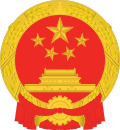1978 Constitution of China
| Constitution of the People's Republic of China | |
|---|---|
| Overview | |
| Jurisdiction | 1975 Constitution of the People's Republic of China |
| Full text | |
 |
|---|
|
|
The 1978 Constitution of the
Content
The number of articles grew from the 1975 Constitution's 30 articles to double the amount. The courts and the procurates, which were minimized or dumped altogether in the
The 1978 Constitution was the first Constitution in the PRC to touch explicitly on the
Citizen rights were also reinstated somewhat. The right to strike was still present, although it would be removed in the 1982 Constitution. However, the required support for the leadership of the Chinese Communist Party and the socialist system remained as part of citizens' duties.
Altogether, the Constitution still suffered from the backdrop of the just-gone-by Cultural Revolution. Revolutionary language was still persistent (such as "Revolutionary Committees"), although the slogans were gone. The 1978 Constitution survived for four years before being superseded by the current (1982) Constitution of China during the Deng Xiaoping era.
Although short-lived, the 1978 Constitution witnessed the first time since the 1950s that the document was considered authoritative enough for its provisions to remain within the Communist Party's attention. For instance, after the Democracy Wall movement saw students using the constitutionally-guaranteed right to use big-character posters to criticize the government, the party responded by ordering a series of constitutional amendments which deleted this right in 1980. Previously, during the Tiananmen Square incident in 1976 when this same right had been invoked to criticize the Cultural Revolution, protests were forcibly suppressed without the relevant constitutional provisions being acknowledged in any way by the authorities.
In addition to inheriting some fundamental principles from the 1954 Constitution, the 1978 Constitution officially included the Four Modernizations policy with an emphasis on socialist democracy, scientific and educational development. It also mandated in the preamble part that China must "be constructed into a great, powerful, modern socialist country in agriculture, industry, national defense, science and technology within the century".
References
- ^ Yan, Sun (1995). The Chinese Reassessment of Socialism, 1976-1992. Princeton University Press. pp. 127–128.
External links
- The Constitution of the People's Republic of China (1978)
- The Constitution of the People's Republic of China (1978)
